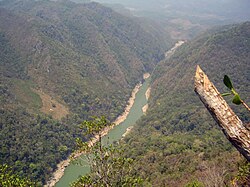
Back نهر اسوماسينتا ARZ Ríu Usumacinta AST اوسوماسینتا چایی AZB Усумасінта Byelorussian Usumacinta Catalan Usumacinta (suba) CEB Usumacinta Czech Усумасинта CV Usumacinta German Río Usumacinta Spanish
This article needs additional citations for verification. (January 2008) |
| Usumacinta River | |
|---|---|
 | |
| Native name | Río Usumacinta (Spanish) |
| Location | |
| Countries | Guatemala and Mexico |
| State | Tabasco, Chiapas |
| Municipality | Tenosique, Balancán, Emiliano Zapata, Jonuta and Centla |
| Physical characteristics | |
| Source | Confluence of Chixoy River and Pasión River |
| • location | Esperanza, Petén Department, Guatemala |
| • coordinates | 16°00′00″N 90°32′35″W / 16°N 90.542942°W |
| Mouth | Gulf of Mexico |
• coordinates | 18°38′58.20″N 92°28′4.0″W / 18.6495000°N 92.467778°W |
• elevation | 0 m (0 ft) |
| Length | 1,000 km (620 mi)[1] |
| Basin features | |
| Tributaries | |
| • left | |
| • right | |


The Usumacinta River (Spanish pronunciation: [usumaˈsinta]; named after the howler monkey) is a river in southeastern Mexico and northwestern Guatemala. It is formed by the junction of the Pasión River, which arises in the Sierra de Santa Cruz (in Guatemala) and the Salinas River, also known as the Rio Chixoy, or the Rio Negro, which descends from the Sierra Madre de Guatemala. It defines part of the border between Guatemala and the Mexican state of Chiapas, then continues its northwesterly course, meandering through the Mexican state of Tabasco to the Gulf of Mexico.
The Usumacinta River enters Mexican territory in the state of Tabasco and across the Cañón del Usumacinta (Usumacinta Canyon) ecological reserve, forming impressive canyons along its route. Passing the canyon called "Boca del Cerro", Tenosique, the Usumacinta goes into the plain of Tabasco.
Two distributaries, the Palizada River and San Pedro y San Pablo River, branch from the main stem of the Usumacinta and empty north and east into the Laguna de Términos. In Tabasco the Grijalva River flows into the Usumacinta River. This confluence is at Tres Brazos, Centla, and the two rivers form a large wetland region known as the Pantanos de Centla. The pantanos (wetlands) are designated a biosphere reserve; it contains 302,702 hectares (747,990 acres), which makes it the largest protected wetland region in North and Central America and one of the top 15 wetlands (by size) in the world.[2]
The total length of the river, including the Salinas, Chixoy, Negro rivers in Guatemala is approximately 1,000 kilometres (620 mi).[1][3] It is the only visible natural boundary separating the Yucatán Peninsula from Mexico.
- ^ a b Encyclopædia Britannica. "Usumacinta River". Retrieved 1 January 2008.
- ^ UNESCO (2011). "Wetlands of Centla and Términos". Retrieved 1 January 2012.
- ^ CONAGUA (2003). "Disponibilidad de aguas subterráneas en el acuífero Palenque, Estado de Chiapas" (PDF). p. 9. Archived from the original (PDF) on 11 September 2008. Retrieved 1 January 2008.
